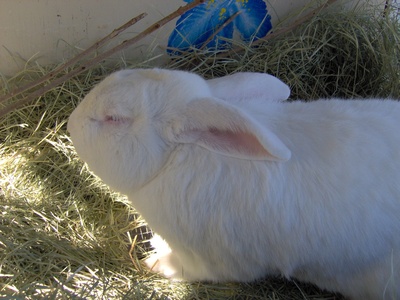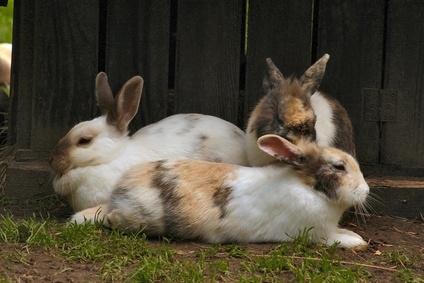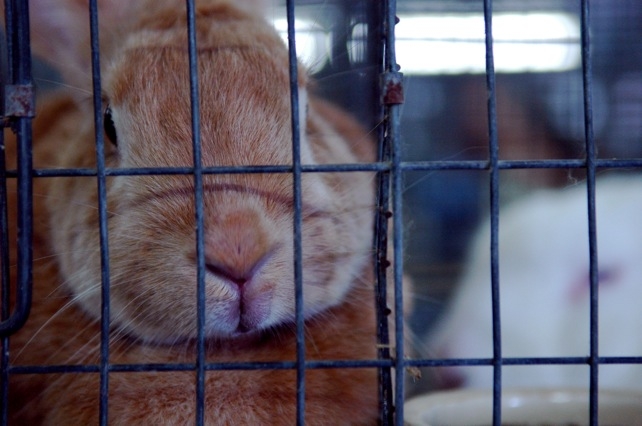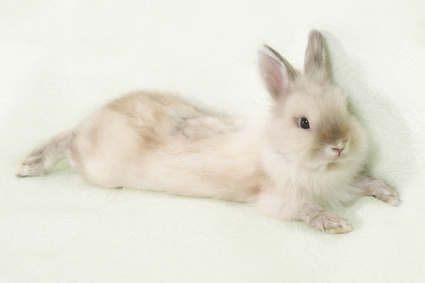
Although it may seem like a matter of common sense, many first-time rabbit owners do not know how to properly hold a rabbit. Some think of rabbits as being similar to cats or dogs, and pick them up by the scruff of their necks. Others have been misled by popular representations of magicians pulling rabbits out of hats by their ears. Both of these techniques are excellent ways to cause pain and injury to a rabbit. You must remember that, in the wild, if a rabbit is "held" by anything, it is probably about to be eaten by a predator. They are not truly "designed" to be handled. Handling a rabbit in such a way as to not cause injury or discomfort is a specific skill that every rabbit owner must learn.
The first and most important cardinal rule of handling your rabbit is to never pick it up if it struggling to escape. Rabbits have powerful flight responses, and when they become fearful they are capable of exerting great strength and ferocity in attempting to escape- even to the point of injuring themselves. One of the most common sources of serious injury to rabbits results from improper handling by a human. The rabbit becomes agitated and begins to kick with its powerful legs. These muscular appendages, which allow it to leap and bound so powerfully, are connected to a very light, fragile skeletal system. If allowed to flail wildly, with no solid ground to connect with, the rabbit is quite capable of dislocating or fracturing its spine with the power of its own kicks. For this reason, you should never pick up a rabbit against its will.
Conversely, once you have a rabbit in your arms, you must provide a secure and solid surface for it to press against. A rabbit may begin to kick and thrash trying to escape- in this case, it is important that you not release it until it has calmed. As long as the rabbit is held close to your body, where its legs cannot lash out into the air, it should not be able to injure itself. Using a soothing voice and calmly stroking its head, allow it to calm down before releasing it. Apart from the risk of injury, releasing a rabbit that is struggling will teach it that this is an acceptable escape strategy.
The easiest way to pick up your rabbit begins with a little bit of affection. "Groom" your rabbit by scratching or stroking it on the head and face, and speak to it in a calm, soothing voice. When it appears relaxed, place one hand under its chest, behind the front legs. Bring your other hand under its haunches, and as you lift, bring it in close to your body. The longer the rabbit feels itself hanging in "thin air", the more likely it is to panic. Make sure to always support its hind legs, to prevent spinal dislocation as mentioned above.
When carrying the rabbit, you can either hold it so that your chests are facing each other, and all four of its feet are resting against your toso; or, hold it with its side against your chest. Either way, you should always have one hand firmly supporting its hind legs, and another firmly grasping its chest (or back, if you are holding it chest-to-chest). When you are ready to release your rabbit, simply repeat this process in reverse. Bear in mind that once freedom is in sight, an ostensibly relaxed rabbit may suddenly leap away. Try to keep it firmly held until it is all the way on the ground, as you don't want it kicking free or dashing headlong into an obstacle.
The final element of your rabbit's "training" is to reward its patience and tolerance for your attentions with a nice little treat- either a small bit of commercial rabbit treat, a little bit of fruit, or some fresh greens. Rabbits do not respond well at all to negative reinforcement, but they are plenty smart enough to recognize positive reinforcement for what it is. As your rabbit learns to associate being held with comfort, security, and tasty treats, it should become more and more manageable.
These guidelines may seem burdensome, or contrary to the major appeal of rabbits: their "cuddliness". Simply because rabbits do not generally care to be lifted or held does not mean that they are not affectionate, social animals. They simply have a natural history that differs greatly from animals such as dogs and cats, and this fundamental "rabbitness" must be respected. Small children will probably have a hard time understanding why they can't treat Real Rabbit the same way they treat Stuffed Rabbit, and if you have children in the house it is very important to explain and demonstrate to them how to handle their rabbit, and why. If this seems unreasonable to you, you may be better off buying a more traditional pet, or perhaps a python. Otherwise, we wish you many happy days of cuddling and knoodling with your rabbit friend!
 The Safest Way to Disinfect a Used Rabbit Cage
The Safest Way to Disinfect a Used Rabbit Cage
The Safest Way to Disinfect a Used Rabbit Cage
The Safest Way to Disinfect a Used Rabbit Cage
 How to Calm a Thumping Rabbit
How to Calm a Thumping Rabbit
How to C
How to Calm a Thumping Rabbit
How to Calm a Thumping Rabbit
How to C
 Male Vs. Female Rabbits
Male Vs. Female Rabbits
Male Vs. Femal
Male Vs. Female Rabbits
Male Vs. Female Rabbits
Male Vs. Femal
 How to Build a Wood Framed Rabbit Cage
How to Build a Wood Framed Rabbit Cage
How to Build a Wood Framed Rabbit Cage
How to Build a Wood Framed Rabbit Cage
 How to Make Urine Guards for Rabbit Cages
How to Make Urine Guards for Rabbit Cages
How to Make Urine Guards for Rabbit Cages
How to Make Urine Guards for Rabbit Cages
Copyright © 2005-2016 Pet Information All Rights Reserved
Contact us: www162date@outlook.com